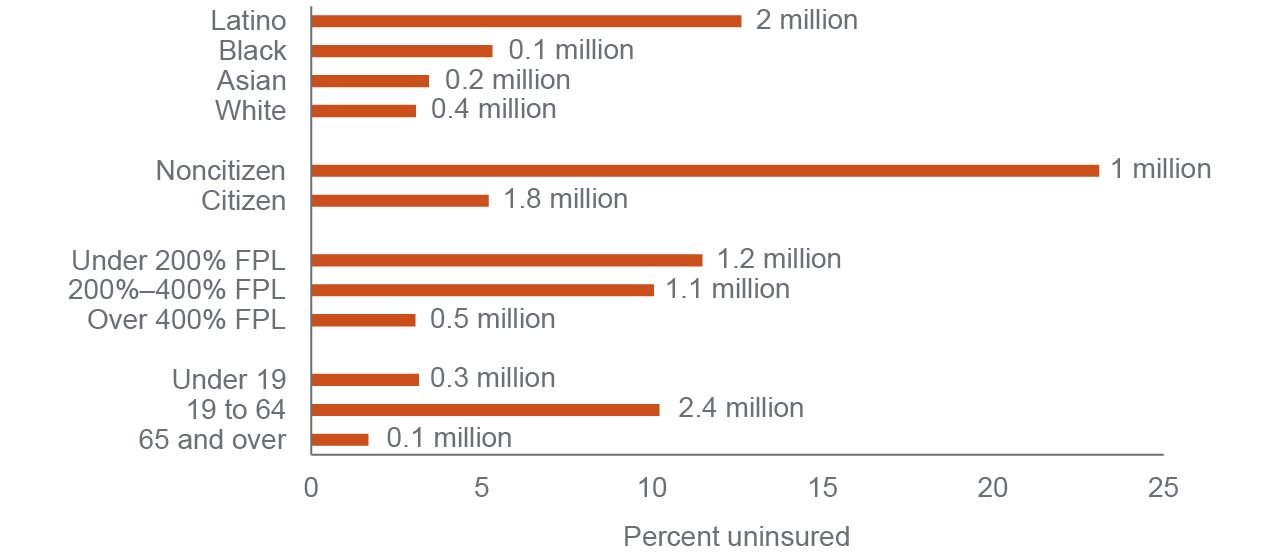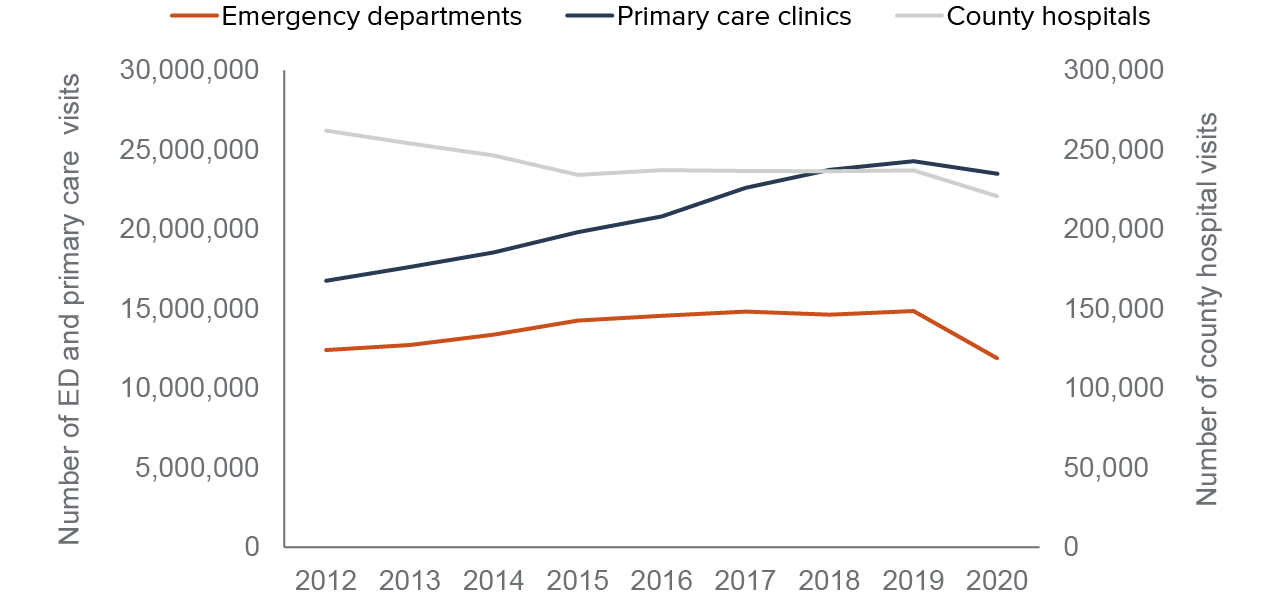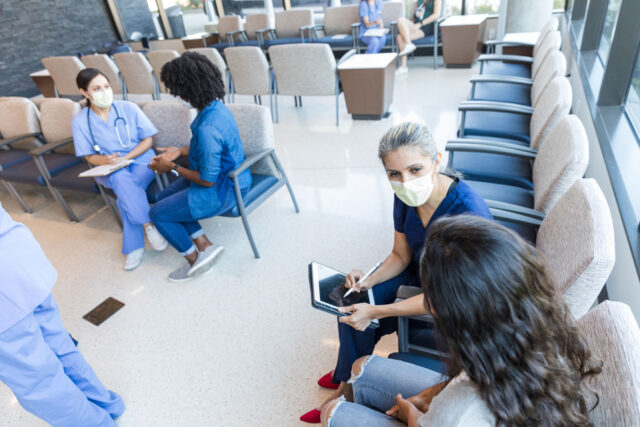Millions of Californians rely on the health care safety net.
- The health care safety net is a patchwork of programs and providers that deliver health coverage and care to people with low incomes, no private insurance, and other special medical needs.
- Medi-Cal—California’s version of Medicaid—is the cornerstone of the state’s health care safety net. The state-federal program provided health coverage for more than 14.2 million low-income Californians in September 2021 and serves as the primary funding source for safety net providers. Other funding sources include counties, provider fees, and patient revenue.
- Additional state and county programs offer limited access to health care for people not eligible for public insurance programs and those with specific health conditions.
- Core safety net providers—including county hospitals, health clinics, and emergency departments (EDs)—are located throughout the state and treat patients regardless of their ability to pay or immigration status.
The health care safety net has expanded dramatically in recent years.
- After coverage expansions under the Affordable Care Act (ACA) in 2014, the number of uninsured Californians declined steeply as the Medi-Cal program grew. Since the onset of the pandemic, Medi-Cal enrollment has increased by about 1.8 million, in part due to a federal requirement that eligibility redeterminations be paused during the public health emergency.
- Still, more than 2.8 million California residents reported being uninsured at the beginning of 2021. Nearly three-quarters of uninsured Californians are Latino, 80% have low or moderate incomes (below 400% of the federal poverty line), and about 35% are not US citizens.
Latinos, low- and moderate-income residents, and noncitizens have higher uninsured rates

SOURCE: California sample of the Current Population Survey, Annual Social and Economic Supplement, 2021.
NOTES: Survey data was collected between February and April of 2021, and response rates continued to be lower than previous years due to the pandemic. The health insurance question reflects whether the respondent reported any health coverage at the time of the survey.
The COVID-19 pandemic led to declines in health care visits.
- Prior to the pandemic, health clinics saw steady growth in visits, while visits to hospital emergency departments had levelled off and inpatient visits to county hospitals had declined slightly. In 2020, all health care safety net providers saw declines in health care visits.
- The Medi-Cal program, along with California hospitals and health care clinics, received large infusions of federal funds through pandemic relief efforts, including the CARES Act and the American Rescue Plan Act.
- Given the disproportionate impact of COVID on lower-income communities, it will be important to monitor the health care safety net’s ability to provide care to Californians who may now have greater health needs as a result of the pandemic.
Hospital emergency departments saw the largest declines in visits due to the pandemic

SOURCES: California Department of Health Care Access and Information, Primary Care Clinic Annual Utilization Data and Hospital Annual Utilization Data.
NOTES: Visit counts for primary care clinics only include health clinics licensed by the state; some health clinics, including county-operated clinics, do not report data to the state and are not included in the clinic visit totals. Clinic visit totals for 2020 have been imputed for 26 non-responding clinics based on their 2019 visit totals adjusted by the median decline in visits from 2019 to 2020 among all responding clinics. County hospital visits include inpatient stays at the 19 county hospitals that operated throughout the period.
County hospitals are vital safety net providers.
- Twelve large counties—home to about 60% of California’s population—operate county hospital systems. In addition to providing care, these hospitals help train physicians and operate high-level trauma centers.
- All county hospitals—and other hospitals that serve high shares of uninsured and Medi-Cal patients—receive supplemental funds to help cover costs because Medi-Cal pays hospitals less than Medicare and private insurance.
- In 2020, Medi-Cal patients accounted for more than 60% of hospitalizations at county hospitals and nearly half of hospitalizations at other hospitals that receive supplemental funding—compared to only about 20% at all other hospitals in the state.
Primary care clinics also play a critical role.
- About 1,300 state-licensed health clinics delivered more than 23 million primary care visits in 2020, a drop of about 800,000 visits from the prior year.
- The majority of clinic patients are Latino, about 30% are children, more than 10% are seasonal farmworkers, and only 10% are covered by private insurance.
- Primary care clinics rely heavily on Medi-Cal—about 70% of their net revenue comes from the program. Health clinics are typically paid per visit so the decline in visits during the pandemic affected their finances, though federal relief funds should have provided some buffer.
Emergency departments are “the safety net of the safety net.”
- In 2020, there were 325 hospital emergency departments that operated throughout the year and provided 24-hour access to health care services. Federal law requires emergency departments to provide necessary treatment to all patients who seek care.
- About 11.8 million visits were made to California’s hospital emergency departments in 2020—a 20% decline compared to 2019.
- Prior to the pandemic, ED visits had levelled off at about 14.7 million per year after steadily increasing through 2016. Our recent study found these increases were not driven by ACA coverage expansion, which had been a concern given the high cost of ED visits.



